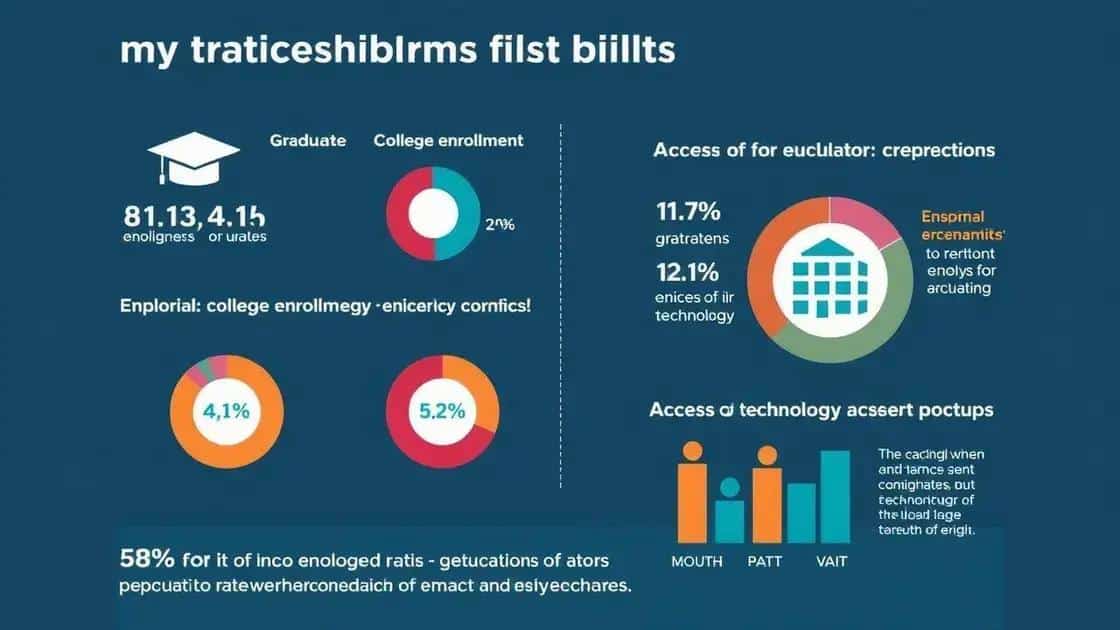think education equity news: what you need to know

Education equity ensures all students have equal access to resources and opportunities, addressing disparities in education based on socioeconomic status, race, and geographic location.
Think education equity news is more than just a headline; it’s a vital conversation we’re having about fairness in our education system. Have you noticed how it influences access and opportunities for students? Let’s dive into what this really means for us all.
Understanding education equity
Understanding education equity is essential for creating fair opportunities for all students. It means ensuring that every child has access to the resources they need to succeed, regardless of their background. This approach leads to a more inclusive and effective education system.
What is Education Equity?
Education equity is about fairness in education. It focuses on different needs and circumstances, ensuring every student can thrive. Factors like socioeconomic status, race, and ability can affect a student’s educational experience.
Key Components of Education Equity
- Access to Resources: All students should have materials like books, technology, and experienced teachers.
- High Expectations: Every student deserves high expectations from their educators, which inspires them to achieve their best.
- Diverse Curriculum: A curriculum that reflects different cultures and experiences promotes engagement and understanding among all students.
When we talk about education equity, we need to think about how different factors influence each child’s learning journey. For instance, a child from a low-income family may face challenges that others do not. Addressing these disparities is vital.
Also, consider how policies affect equity. Schools in richer areas often receive more funding than those in poorer communities. This can lead to unequal opportunities among students. Advocating for fair funding is crucial in promoting education equity.
The Importance of Community Involvement
Communities play a significant role in achieving education equity. When parents and local organizations engage with schools, they help create a supportive learning environment. Strong community ties also lead to better resources and opportunities for students.
Education equity not only benefits individuals but also strengthens communities. When all students succeed, everyone gains from a better-educated population. A focus on equity can transform lives and increase opportunities for future generations.
The impact of education equity on communities
The impact of education equity on communities is profound and transformative. When education is equitable, it not only changes the lives of individual students but also improves the overall health and prosperity of entire communities.
Economic Growth
Communities that prioritize education equity tend to experience economic growth. This occurs because educated individuals contribute more effectively to the workforce. They bring skills and innovation, which can boost local economies.
Social Cohesion
Education equity fosters social cohesion by bringing diverse groups together. When students from various backgrounds learn and collaborate in a fair environment, they develop respect and understanding for one another. This can lead to stronger community bonds and reduced tensions.
- Stronger networks: Families are more likely to connect with each other, creating a support system.
- Increased volunteering: Educated individuals often engage more in community service activities.
- Enhanced civic engagement: Education encourages participation in local governance and decision-making.
Another vital aspect is that education equity leads to better health outcomes. Research shows that communities with high education levels have lower rates of crime and improved public health. When children receive equitable education, they are likely to grow into informed adults who make healthier choices.
The ripple effects of education equity extend to all ages. Parents who are educated are often more involved in their children’s schooling, which directly influences student performance. Furthermore, when parents engage with schools, they advocate for better resources and programs, benefiting everyone in the community.
Long-Term Sustainability
Focusing on education equity also promotes long-term sustainability within communities. When everyone has equal chances for success, it creates a cycle of achievement. Future generations benefit from the groundwork laid by those who fought for fair access to quality education.
In essence, addressing education equity is not merely a moral imperative; it is smart economics and a path to a thriving society. Communities that embrace fairness in education can look forward to a brighter, more unified future.
Key statistics related to education equity

Key statistics related to education equity provide insight into how disparities affect students and communities. Data helps highlight the importance of promoting fairness in education.
Understanding the Disparities
Studies show significant gaps in education based on socioeconomic status, race, and geographic location. For example, students from low-income families are less likely to have access to advanced courses. This often limits their opportunities for higher education.
Statistics on Educational Achievement
- Graduation Rates: In many areas, high school graduation rates for low-income students are 20% lower than those for students from wealthier families.
- Standardized Testing: Research has shown that students in underfunded schools often score significantly lower on standardized tests.
- College Enrollment: Only 54% of students from low-income families enroll in college compared to 81% from higher-income families.
These figures underscore the critical need for equitable education systems. When we look closer at these statistics, we see how education inequity can lead to long-term consequences for individuals and society.
Moreover, access to resources like technology is crucial. In fact, nearly one in four students in low-income communities lacks high-speed internet access. This gap hinders their ability to complete homework and participate in digital learning.
Impact on Communities
The impact of these statistics stretches beyond education. Communities with lower educational attainment often face higher unemployment rates and lower overall income levels. This creates a cycle of poverty that is difficult to break.
Addressing education equity is not just an individual concern; it is vital for community health and economic growth. Communities that prioritize education see improvements in public health, crime rates, and overall quality of life.
Challenges in achieving education equity
Challenges in achieving education equity can significantly affect many students and communities. Despite efforts to create a fair educational system, several obstacles continue to arise.
Funding Disparities
One major challenge is funding disparities between schools. Wealthier districts tend to have more resources, while schools in low-income areas struggle to provide basic supplies. This gap leads to unequal opportunities for students.
Access to Trained Educators
Another critical issue is the lack of trained educators in underserved areas. Many schools face difficulties attracting and retaining qualified teachers. Students in these schools often do not receive the high-quality instruction they need and deserve.
- Turnover rates: High turnover rates among teachers can disrupt learning and affect student performance.
- Professional development: Limited access to training opportunities for teachers in low-income districts can hinder their effectiveness.
- Teacher salaries: Lower salaries can make it harder to recruit skilled teachers, leading to a cycle of underfunded education.
Furthermore, systemic barriers such as racism and discrimination also play a significant role in education equity. Students from marginalized communities often face additional hurdles that affect their learning environments. Issues such as bullying and implicit bias can create toxic educational settings.
Access to technology is another pressing challenge. In today’s digital age, many students still lack reliable internet and devices necessary for learning. This situation is especially pronounced in low-income areas, impacting their ability to complete assignments and engage in online learning.
Community Awareness and Involvement
Lastly, community awareness and involvement can significantly influence education equity. Many communities may not recognize the importance of advocating for change. Without strong parent and community engagement, it can be difficult to push for the necessary reforms needed in the education system.
Addressing these challenges requires ongoing efforts from educators, policymakers, and communities. Collaborative actions are crucial to overcoming the barriers that continue to perpetuate inequity in education.
Ways to promote education equity
Ways to promote education equity are essential for creating a more fair and inclusive educational system. Everyone can contribute to this cause, from teachers and parents to policymakers and community members.
Advocating for Policy Changes
One important way to promote education equity is by advocating for policy changes at the local, state, and national levels. Effective advocacy can lead to increased funding for under-resourced schools. This funding can help provide better facilities, teacher training, and educational materials.
Increasing Community Involvement
Community involvement plays a vital role in promoting education equity. When community members actively engage with schools, they can help create a positive learning environment. This can include volunteering, attending school meetings, and organizing educational events.
- Parent-Teacher Associations: Building strong PTAs can foster better communication between families and schools.
- Mentoring Programs: Mentoring relationships can support students and provide them with guidance.
- Community Partnerships: Collaborating with local organizations can bring additional resources and support to schools.
Another effective strategy is to implement culturally relevant curricula. A curriculum that reflects the diverse backgrounds of students can engage them more effectively. When students see their cultures represented in what they learn, it can foster a sense of belonging and motivation to succeed.
Providing Access to Technology
Access to technology is crucial for education equity. Schools should strive to provide students with reliable devices and internet access, especially in underserved communities. This can make a significant difference in how students learn and participate in class activities.
Finally, training and supporting teachers is essential for promoting equity in the classroom. Schools need trained educators who understand the importance of equity. Professional development opportunities can help teachers become more effective in meeting the diverse needs of their students.
By taking these steps, we can move toward a more equitable education system. Everyone has a part to play in this important work.
In conclusion, promoting education equity is a shared responsibility that requires effort from everyone involved. By focusing on advocacy, community involvement, and access to resources, we can create a more equal education system for all students. Emphasizing technology, training educators, and implementing inclusive curricula also play vital roles. Together, we can break the barriers that prevent students from reaching their full potential and ensure brighter futures for all.
FAQ – Frequently Asked Questions about Education Equity
What is education equity?
Education equity means ensuring that all students have access to the resources and opportunities they need to succeed in school, regardless of their background.
Why is education equity important?
Education equity is crucial because it helps level the playing field, allowing all students to reach their full potential and contribute positively to their communities.
How can I get involved in promoting education equity?
You can advocate for policy changes, volunteer in local schools, and engage in community activities to support educational improvements.
What are some challenges to achieving education equity?
Challenges include funding disparities, lack of access to trained educators, systemic barriers, and inadequate technology resources for students.






